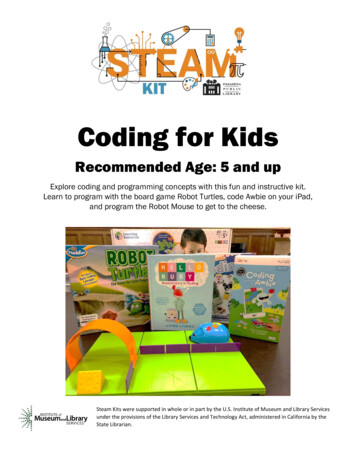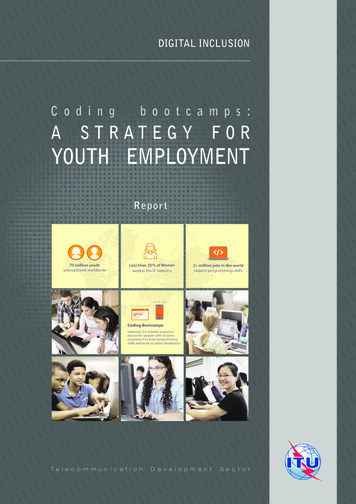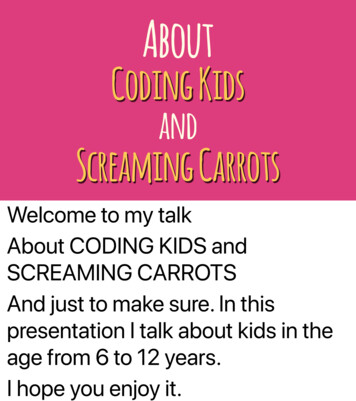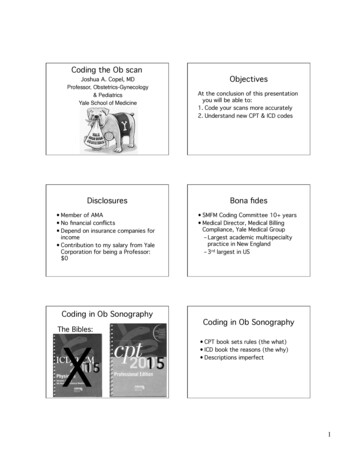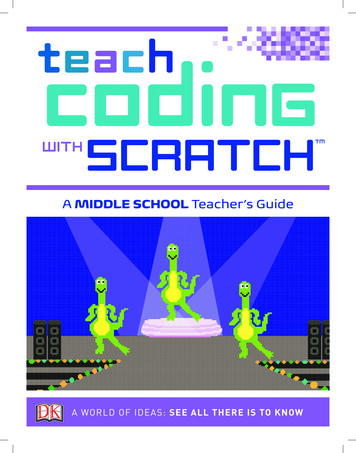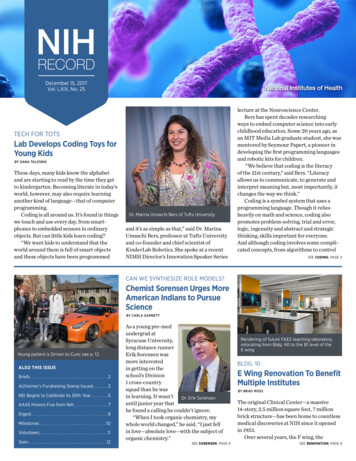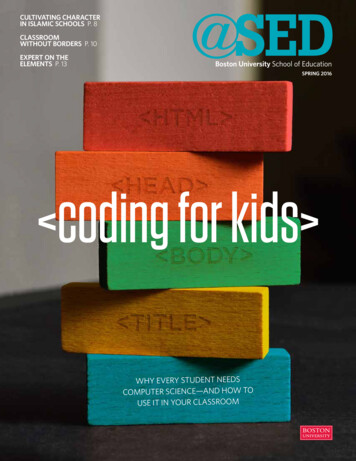
Transcription
CULTIVATING CHARACTERIN ISLAMIC SCHOOLS P. 8CLASSROOMWITHOUT BORDERS P. 10EXPERT ON THEELEMENTS P. 13SPRING 2016 coding for kids WHY EVERY STUDENT NEEDSCOMPUTER SCIENCE—AND HOW TOUSE IT IN YOUR CLASSROOMbu.edu/sed1
I want to take this opportunity to thank you for all thesupport you give the School of Education, throughgifts and the time you spend mentoring our studentsand recent alumni. Your donations are critical toour ability to support research and send faculty toconferences. They allow us to renovate classrooms,bring speakers to campus, and provide scholarshipsto deserving students. Your mentorship helpsguide students and young alumni as they enter theprofession. You are an important part of what allowsus to provide a high-quality learning community forour students and faculty.In this issue of @SED, you will learn about therange of work we accomplish as a community. Inour cover story, you will learn why computer scienceskills are critical to education, and how our alumsare using the latest coding tools to shape the waychildren learn. You will read about SED researchthat deepens our understanding of Islamic studentsin America, and about an initiative by one of ourdoctoral students that is enriching the lives of youngpeople in Nicaragua and Uganda. You’ll also hearfrom an educator and fellow alum on how to supportparent involvement in closing the achievement gap.The School of Education is a vibrant learningcommunity both in Kenmore Square and around theglobe. If you have not had a chance, come back tovisit or stop in at an alumni event in your region. Visitbu.edu/sed/alumni to stay current on SED news andevents, and to share your updates. We look forwardto hearing from and about you.4COVER STORYCODING FOR KIDSWhy every student needs computer science—and how to use it in your classroom2ALUM SPOTLIGHT8RESEARCH10IN THE WORLDSED award winners are masters of adversityNew Jersey Devils head coach John Hynes (’97) talks to players during NHL hockey training camp in September 2015 in Newark, NewJersey. Hynes, who played at BU under retired men’s ice hockey head coach Jack Parker (Questrom’68, Hon.’97) and coached thePittsburgh Penguins American Hockey League affiliate in Wilkes-Barre/Scranton, was appointed to the Devils—his first NHL coachingjob—in June 2015. At 41, he’s the youngest head coach in the NHL.—jbInside US Islamic schoolsA new kind of camp for kidsIS SPECIAL ED GETTINGSHORT SHRIFT?12OP-ED13SNAPSHOTDo school districts use unfair methods to evaluate special education teachers? Nathan Jones is conducting a four-year study tofind out. Jones, an assistant professor of special education whoformerly taught special ed students in Arkansas, received 1.6 million from the US Department of Education to determine if the mostwidely used tool for evaluating teachers is applicable to those inspecial education.The Framework for Teaching (FFT), which is used in about 20states, couples classroom observations by principals and otheradministrators with documentary evidence and colleagues’ input.But special educators, whom Jones points out are trained “very differently than general educators,” think it discriminates against bestpractices in their field. For example, “kids with disabilities benefit[when] a teacher provides lots of modeling, talking through whatthey’re doing, showing a student with clear, simple language whatthe steps are to complete a problem,” he says. “Yet the instrumentsused to evaluate teachers focus on classroom practices where theteacher takes a less central role.” He also points out that general edteachers plan instruction for a classroom of students, whereas special ed instruction is often focused on an individual.Jones hopes his research will shed light on the ongoing assessment debate. But discovering that methods like FFT are unfair tospecial ed teachers would raise another question: would districtsand states foot the bill for a new system to evaluate them?—rich barlow and julie buttersClosing the achievement gap: step oneExpert on the elementsCOVER PHOTO ILLUSTRATION: RAQUEL SCHOTT; ISTOCK/GETTY IMAGESBoston University School of EducationHardin L. K. Coleman, Dean and ProfessorBoston University School of EducationTwo Silber WayBoston, MA 02215617-353-3213hardin@bu.edu2Boston University School of Education spring 2016NEWS&NOTESSPRING 2016DeanHardin L. K. ColemanEditorJulie ButtersManager of Marketing& CommunicationsJonathan LazzaraContributing WritersRich BarlowLara Ehrlich (UNI’03)Andrew ThurstonMargaret Daniels Tyler (’76)Produced byBoston University Marketing& CommunicationsSenior Graphic DesignerRaquel SchottRecyclable. 0216 Printed on Forest Stewardship Council–certified paper.AP PHOTO/JULIO CORTEZDEAR ALUMNI AND FRIENDS,CONTENTSLEFT: GEORGE RILEY PHOTOGRAPHY; RIGHT: PHOTO ILLUSTRATION, RAQUEL SCHOTT; ISTOCK/GETTY IMAGESDEAN’SMESSAGECONVERSATION STARTER“Where do I learn American Sign Language?” is a question Deafpeople often receive from loved ones. Megan Malzkuhn (’16),her brother Matt, sister Melissa, and friend Tim—all of whom areDeaf—came up with an answer. The four, who comprise the mediacompany Ink & Salt, developed The ASL App (theaslapp.com) tohelp the hearing “include their Deaf family members, coworkers,children, and friends in their conversations,” says Malzkuhn.The app, which is free and offers add-ons for a small price, usesvideos equipped with slow-motion replay to teach more than800 words and phrases. It won the People’s Choice Award atthe 2013 Pitch Night for the Media Rise Festival, which supports“meaningful media,” and was released in May 2015.The ASL App has features similar apps don’t, says Malzkuhn,the project’s designer, editor, and graphics specialist. It takesusers beyond the dictionary to everyday exchanges, from orderingat a restaurant to making conversation with a potential date. Itexplains the differences between fingerspelling, gesturing, andtransliteration, and is grammatically correct in both ASL andEnglish. Creating the app also provided a “platform for Deaftalents—developers, signers, and designers,” says Malzkuhn.If Apple store reviews are any indication, the app is meetingan important need. One user wrote, “My daughter is Deaf and Ihad been discouraged that most apps just teach one word at atime. This app teaches how to converse with others.” Anotherexpressed relief: “Finally an ASL app [whose signs I can trust] tobe accurate among the Deaf community.”—jbbu.edu/sed1
ALUMSPOTLIGHTMasters of AdversitySED’s distinguished alums cultivate peace in Israel, raiseawareness of the Deaf, and empower English-language learnersBY JULIE BUTTERS2Boston University School of Education spring 2016ali jabareenA PEACE MISSION INISRAEL’S CLASSROOMSINTERNATIONAL ALUMNI AWARDWitnessing the violence of thePalestinian uprising known as theSecond Intifada in 2000 moved AliJabareen to build interfaith understanding in Israel’s classrooms.A Palestinian Arab, Jabareen(’07) was visiting Israel, his birthcountry, to research his SED dissertation on educational disparitiesbetween Arab and Jewish youths.Shocked by the violence, he decidedto join the staff of Al-QasemiAcademic College of Education, anArab institution in Israel where heis now dean of the faculty of thehumanities. He and his colleaguesre-envisioned the institution to helpcreate a more peaceful society.Diversifying the all-Muslim facultywas key to this plan. Today, rabbis,It’s not unusual for students toresist this approach at first, but intime they become more tolerant,says Jabareen. When the studentsbecome teachers themselves, theybring that tolerance into their ownclassrooms, he adds. Jabareensaw a similar transformation whenAl-Qasemi students and those fromlocal Jewish schools conducted theirstudent-teaching at each other’sinstitutions. Jewish students wereinitially wary of their Arab visitors,“but when they finished the course,tears were in [their] eyes becausethey didn’t want these teachersto leave.” Meanwhile, Al-Qasemistudents still talk with their Jewishteachers on social media after theirstudent-teaching exchange.Ongoing tensions in Israel make thecollege’s mission a challenge, but letting violence take its course is not analternative Jabareen accepts: “You feelthat you have no choice [but] to do allthat it takes to arrive with results.”KROL-SINCLAIR PHOTO: CYDNEY SCOTT; BAHAN PHOTO: CHRISTOPHER KERN (HEYKERN.COM)To nominate someone foran SED alumni award, visitbu.edu/sed/alumni/awards/nominations.“You feel that you have nochoice [but] to do all that ittakes to arrive with results.”YOSEF NAGNAGYEach year, SED honorsalums who demonstratedistinguished services tothe School, the field ofeducation, or the community.On September 26, 2015,during Alumni Weekend, SEDpresented benjamin j. bahan(’87, GRS’96) with the IdaM. Johnston Award, namedfor a former SED professorand alum (’42,’43). Bahan isa professor of American SignLanguage (ASL) and DeafStudies at Gallaudet Universityand an ASL advocate. alijabareen (’07), dean of thefaculty of the humanitiesat Al-Qasemi AcademicCollege of Education in Israel,received the InternationalAlumni Award. barbarakrol-sinclair (’82,’96),director of adult learning forChelsea Public Schools inMassachusetts, received theDean Arthur Herbert WildeSociety Award, named for theBU alum (1887, 1891) whobecame SED’s first dean.priests, and imams offer the Arabstudents—whom Jabareen says aremore than 90 percent female andmostly aspiring teachers—theirreligions’ perspectives on topics suchas Israeli and Palestinian holy places,the role of women, and respect forpeople of other faiths.EMPOWERMENT THROUGH ENGLISHDEAN ARTHUR HERBERT WILDE SOCIETY AWARDASL FOR ALLIDA M. JOHNSTON AWARDNot long after Maria Teresa, an industrial engineer from El Salvador,immigrated to the US in 2003, she walked into a Dunkin’ Donuts toorder coffee. But when she couldn’t understand the cashier, she left intears of frustration.Today, Maria Teresa is a US citizen who has done more than master thelanguage. She’s now the manager of a fast food restaurant.Maria Teresa and her daughter learned English with help from BarbaraKrol-Sinclair and staff at the Intergenerational Literacy Program (ILP) inChelsea, Massachusetts. Krol-Sinclair (’82,’96) is the director of adultlearning for Chelsea Public Schools, under which ILP operates in collaboration with SED. She and her colleagues have helped more than 2,600adults and their children learn critical English skills.Krol-Sinclair, also an SED adjunct lecturer, was planning a career inlaw but “fell into education” while volunteering with youth at a juveniledetention center. She’s worked at ILP for 25 years. “Working with familiesis where my greatest passion is,” she says.In 2001, when Ben Bahan became a professor at the world’spremier university of ASL and Deaf studies—Gallaudet, inWashington, DC—he wasn’t used to being looked to as a leader,he says. But Bahan (’87, GRS’96) has become just that in hiscareer as an educator, storyteller, and advocate of ASL.Krol-Sinclair cites “how incremental progress is” asthe biggest challenge of her work. But that’s alsothe job’s biggest reward.ILP is one of the longest-running family literacy programs in the US andis meeting an urgent need. Chelsea is a heavily immigrant community,with a higher percentage of students whose first language is not Englishthan all other public, noncharter school districts in the state. On average,the parents ILP serves have only about eight years of formal schooling andlimited English skills. Krol-Sinclair, her fellow staff, and BU Work-Studystudents help participants learn through lessons and small group activities. Krol-Sinclair says the waiting list is more than 1,000 people long.Transformations don’t happen overnight. Krol-Sinclair cites “how incremental progress is” as the biggest challenge of her work. But that’s alsothe job’s biggest reward.ASL isn’t just for the Deaf, Bahan says;it’s for everyone.Bahan, who is Deaf himself, has been instrumental in shapingGallaudet’s current Deaf studies curriculum. The former directorof SED’s undergraduate Deaf studies program is also the coexecutive editor of the Deaf Studies Digital Journal, known as “theworld’s first online, peer-reviewed academic and cultural artsjournal to feature scholarship and creative work in both signedand written languages”; cowriter and codirector of AudismUnveiled, a film about discrimination against the Deaf; and cofounder of DawnSignPress, which produces ASL-related media.In 2014 he toured internationally to present BLEEVA—A Narrativeof Our Existence, in which Bahan speaks about Deaf people’s rolein the world.“Through Ben’s work, the lives of Deaf people previously invisible are now seen,” said Robert Hoffmeister, an associate professor emeritus of Deaf studies at SED, at the award presentation.Bahan doesn’t just want to help the hearing become moreaware of the Deaf, he wants to help the two communicate. Hesaid in his award speech that parents are starting to introducebabies to ASL through Baby Sign Language—which aids earlycommunication between all babies and parents—but stop signing when babies start talking. That’s a missed opportunity fordeveloping bilingualism, said Bahan. ASL isn’t just for the Deaf,he says; it’s for everyone. nbu.edu/sed3
COVERSTORYIt’s not quite ready for Sesame Street, but thisanimated cartoon, created by a fifth grader for anEnglish class, illustrates a lesson worthy of theshow: to explain the idiom “Hold your horses!” coding for kids WHY EVERY STUDENTNEEDS COMPUTERSCIENCE—AND HOWTO USE IT IN YOURCLASSROOMTOP: DAVID WEISS; MIDDLE AND RIGHT: COURTESY OF MELIKA PANNERIBY LARA EHRLICH4Boston University School of Education spring 2016“Hi, Bobby,” says a tousle-haired teen in slouchy jeans. “Today I’mgoing to the moon, and then I’m going to the park, and then I’m goingto the zoo, and then . . .”“Whoa, man!” says Bobby’s friend with a smirk. “Hold your horses!That is too much to do in one day.”Magically, a little yellow horse appears in Bobby’s palm witha “neigh!”This cartoon was created at the Wilson School in St. Louis,Missouri. The school’s English teacher collaborated with Wilson’stechnology coordinator, Melika Panneri (’00), to integrate MIT’sfree coding program Scratch into the lesson plan. Using Scratch gavestudents the ability to create cartoons with settings, characters, anddialogue—all using code.With readily available programs like Scratch, and the pervasiveness of computer technology in our lives, you might think allschools are helping students learn the coding and programmingskills that are a critical component of computer science. But asurvey conducted by Google and Gallup in 2015 revealed that’snot the case. Only 4 in 10 students in grades K–12 use computersevery day at school, and just a quarter of US schools offer computer science courses—half of which do not include programmingand coding, a key component of the field. This inadequate preparation by our education system has implications for the job market. There are currently 604,689 unfilled computing jobs in thenation; in 2014, only 38,175 computer science graduates enteredthe workforce. And if current conditions hold, by 2022 there willbe 1.3 million open computing positions but only 400,000 totalcomputer science graduates, according to the US Bureau ofLabor Statistics.Computer science “makes up so much of everything we do that weneed to know how to speak that language,” no matter our profession,says Stephanie Golas (’09), an instructional technology specialist atthe Newton Public Schools in Massachusetts. “As educators, we’redoing our students a disservice if we are not integrating technologyinto the classroom.”The Gallup survey found that the most significant reason for thedeficit of computer science learning is not lack of interest amongeducators and families, but the nation’s education system, which isnot designed to accommodate computer science. The subject is notincluded in standardized testing like the MCAS or PARCC, and doesnot count toward graduation requirements in 23 states. Insufficientstaffing and tight budgets, plus the perceived price tag of the necessary equipment, are hurdles many schools find restrictive, especiallyin low-income areas.bu.edu/sed5
COVERSTORYSEE HOW FAR AN HOUR TAKES YOUOne of their strategies: forge partnerships.Computer scientists, start-ups, entrepreneurs,and tech companies like Google, Microsoft,and Apple are developing programs to helpschools integrate computer science educationinto the curriculum.Golas works with code.org, a nationalnonprofit that expands access to computerscience and advocates for its inclusion in thecore curriculum. Since its launch in 2013,code.org has trained 16,000 new teachers, likeGolas, to bring the subject into K–12 classes.The organization hosts the Hour of Code,a global effort to demonstrate accessible andcost-effective ways to incorporate technologyinto education. The annual campaign takesplace during Computer Science EducationWeek in December, but anyone can organizean Hour of Code, during which studentscomplete a one-hour self-guided coding exercise on any device. There are free activitiesfor all ages and experience levels, as well asunplugged activities that teach computationalthinking without technology.“Very quickly, we were able to change a lotof minds by trying the Hour of Code, whichhas a very low buy-in,” says Golas, who wastrained as an independent contractor by6Boston University School of Education spring 2016“When kids first start[coding], it is reallyhard for them, andthey want to giveup. But [eventually] they don’t care thatthey messed up 100times before they gotit right. They knowthat’s how peoplemake improvementsand find solutions.”melika panneri (’00)code.org to run professional developmentworkshops for other teachers in Massachusetts. “We’re saying, ‘Just give us an hour, andhave your students try it.’” In 2013, more than22 million students across the world participated in the event, which has been promotedby scientists, celebrities, and politicians—including President Barack Obama.“We’re starting too late when it comes tomaking sure that our young people are familiar with not just how to play a video game,but how to create a video game,” Obama said,advocating for more students and teachersto get involved in the Hour of Code.Panneri has seen the problem the president described in her own school. When shebegan her job seven years ago, Panneri foundthat the older students were eager to makevideo games and virtual worlds, but lackedeven the basic skills required to do so. Sheworked with her colleagues to begin teachingcomputer education in second grade so “bythe time they’re in sixth grade, they can maketheir dream projects,” she says.In one such project, fourth grade students use the coding platform Scratch toconstruct virtual Viking worlds in theirsocial studies class. They team up tobecome experts on a well-known Vikingfrom history, then use their research tocode a world through which players directthe character on voyages, supply-gatheringexcursions, and other adven tures. Not onlydo projects like this impart academic andcomputer science knowledge, they also promote intangible skills like problem-solvingand perseverance.“When kids first start [coding], it is reallyhard for them, and they want to give up,”Panneri says. “But by the time they graduate sixth grade, those things fly off theirbacks. They don’t care that they messedup 100 times before they got it right. Theyknow that’s how people make improvements and find solutions.”The success of projects like the virtualViking world is contingent upon blendingcomputer science into the core curriculum,FROM LEFT: AP PHOTO/JACQUELYN MARTIN; DAVE GREENSED alums including Golas andPanneri have come up with strategiesfor bringing computer science into K–12classrooms—without a blockbuster budget.A middle school student explains a coding learning programto President Barack Obama during a 2014 Hour of Codeevent in Washington, DC.Melika Panneri (’00) helps students in her school use coding to createvideo games, add multimedia to research projects, and more.FROM LEFT: DAVE GREEN; DAVID WEISSStephanie Golas (’09) trains teachers to use resourcessuch as the game Maze to help their students learn code.as opposed to simply teaching computerprograms. “You’re never going to find meteaching kids how to use Microsoft Word,”Panneri says. “We might use Word to dosomething—like write a letter to a senator.”The key to integration is collaboration,Panneri says. She visits her fellow teachers’rooms to keep apprised of their curriculumand often suggests projects. As this newapproach to computer science took root atWilson, the other teachers came up withideas. The music teacher invited students tocreate advertising for her musicals, as well asdigital backdrops projected on the school’svideo wall.Integration doesn’t require drastic changesor cutting-edge equipment, Panneri says.Teachers can start small by working computer technology into existing projects. Firstgraders at Wilson perform an annual uniton famous Americans that entails research,note-taking, and drawing. Panneri introducedthe app ChatterPix, which augments imageswith motion, enabling students to bring theirfamous Americans to life. “You don’t have tomake it a technology project,” says Panneri.“It’s just a project, and you happen to beusing technology.”PRODUCE DILIGENT DIGITAL CITIZENSAs educators introduce students to theworld of technology, it’s equally criticalto teach them how to responsibly inhabitthat world. Panneri leads sessions in whichstudents examine case studies, articles, andcourt cases, meet guest speakers like FBIagents, and perform role-playing scenarios to understand their responsibility asdigital citizens. The lessons extend to theircore classes; when they are preparing fora research project, for example, they learnabout reliable sources and copyright law.Panneri leads sessions on digital citizenship for parents as well. “Quite often theydon’t know something as simple as that youneed to be 13 to have a Facebook account,”she says. “So we try to share all the information we have—which apps are dangerous,how to turn off location services on cellphones so pictures of their children don’thave GPS coordinates” when they’re postedonline. Parents also share their own strategies, like making bedrooms technology-freezones and setting devices to request parentalpermission before downloading apps.The use of computer technology “isevolving in the classroom and in educationas quickly as it is evolving in everyday life,”says Golas. Professionals in fields as diverseas medicine and engineering need to useand create websites, apps, and software—allof which require coding. Incorporating computer science in the classroom helps educators prepare students for these careers.Between 2012 and 2014, there was a 50percent increase in students who took theAP computer science exam, which requirescoding knowledge. In 2015, the STEM Edu-Stephanie Golas (’09) runs professional developmentworkshops for K–5 teachers throughout Massachusetts,teaching them to incorporate coding in their classrooms. A TASTE OF TECH These sites offer programmingcourses for kids, games that helpteach coding, and mit.eduthinkersmith.orgtynker.comcation Act, which expands the official definition of STEM education to include computerscience (with positive implications forfederal funding, national awareness, andteacher training), was signed into law. Since2013, more than 201 million students haveparticipated in the Hour of Code.“It’s an exciting time to be workingwith technology and students becauseof how quickly you can make somethingmeaningful and authentic and connect itto the curriculum,” Golas says. “As educators, we are always looking for those kindsof opportunities.” nbu.edu/sed7
RESEARCHRInside US Islamic SchoolsSome Americans are wary ofthese institutions, but a newstudy finds they cultivateengaged citizensISTOCK/GETTY IMAGESBY ANDREW THURSTONepublican presidential candidate Ben Carson might,just might, vote a Muslim candidate into Congress, butnever into the White House. “I would not advocate thatwe put a Muslim in charge of this nation. I absolutelywould not agree with that,” the retired neurosurgeon toldNBC’s Meet the Press in September 2015. Carson’s apparent fear thata Muslim couldn’t cut it at the top doesn’t make him an outlier. Only34 percent of Americans are confident that a Muslim who attaineda position of influence in the US government would be able to do thejob, according to a 2014 Arab American Institute study. An earlierPublic Religion Research Institute survey found 47 percent thoughtIslam incompatible with American values.Despite such views swirling around their religion, Muslim youth atIslamic schools in the United States have found ways to embrace theirfaith and their nation. After examining Islamic schools’ effectivenessin fostering positive character and civic engagement, Charles Glenn, aprofessor of educational leadership, found “how extraordinarily American” the students were. They were just “very normal, good Americankids who also see themselves as faithful Muslims.”With five other BU researchers, Glenn conducted hundreds of interviews with students, parents, and teachers at Islamic schools acrossthe country. The work was part of Moral Foundations of Education, anational project that includes a study of values education across 10different types of schools, from urban to rural and from evangelicalto Jewish. The ongoing project is based at the Institute for AdvancedStudies in Culture at the University of Virginia.Glenn started the study of Islamic schools expecting to hear abouttension: “kids trying to straddle two worlds” and struggling to balancetheir religious identity with their national one. “It was astonishing howseldom that was expressed,” he says. “I quote one kid as saying thatbeing Muslim is his way of being American.” (“America is kind of like amelting pot, right?” said the student, who—like all other study participants—had identifying information removed for the report. “And to beable to blend in, you have to stand out in a way. I think faith gives youthat edge.”)In America and elsewhere, Glenn says, research suggests “kids whoattend faith-based schools are less alienated from their society thankids who attend public schools, where they feel part of a singled-outminority.” He gives the example of Texas teenager Ahmed Mohamed,a Muslim who made national headlines in September 2015 after beingfalsely accused of bringing a bomb to school (it was a homemadeclock). Imagine, Glenn says, the alienation he would have felt if his storyhadn’t provoked sympathy from President Barack Obama and techindustry leaders. As it was, the Mohamed family still left the country.“It’s not unexpected from a social science point of view,” saysGlenn, a former director of urban education and equity efforts forthe Massachusetts Department of Education and founder of BostonTrinity Academy, an evangelical school. “Those kids who feel securelysupported in their identity, while being prepared to function effectivelyin American society, are not as alienated as they might be if they werelike the 14-year-old in Irving, Texas, who was treated like a young ter-rorist. In other words, the kids we’re interviewing aren’t being treatedlike young Mohamed was. They’re not being suspected.”Still, many are suspicious of Islamic schools’ goals. Although thereare only around 235 Islamic schools in the United States—comparethat to more than 6,500 Catholic schools—the web is littered withadvocacy groups and blogs questioning their intentions. In 2013, twostate lawmakers in Tennessee raised concerns about a school vouchersystem when they realized funds could go to Islamic institutions.Islamic schools, contends Turkish American scholar Zeyno Baran inCitizen Islam (Bloomsbury Academic, 2011), “are run by Islamists whoteach children that their primary loyalty is to Islam rather than to theircountries of citizenship.”But Glenn notes that loyalty to God doesn’t necessarily have tocompete with loyalty to nation. He compares allegations like Baran’sto those leveled at Catholic parochial schools in the 19th century,when a rush of immigrants founded their own schools, much to thechagrin of established Protestant Americans. He also says a study inLeaderless Jihad: Terror Networks in the Twenty-First Century (University of Pennsylvania Press, 2008), by government counterterrorismconsultant Marc Sageman, reveals that the majority of a group of 300Islamists arrested for terrorism in North America and Europe learnedabout Islam online or in prison.Surprisingly, Glenn and his team found students got their biggestexposure to American culture not in social studies or history, butIslamic studies. It was during those classes, students said, that they“Kids who attend faith-based schoolsare less alienated from their societythan kids who attend public schools.”charles glenncould talk about their place in society, openly covering topics asdiverse as pop music, painted nails, dating, and sexuality. One educator told the researchers that the purpose of such classes was teaching“how to be a good person.”Glenn’s team also noted that the Islamic schools placed a premiumon fostering community connections, from organizing sports activitieswith neighboring institutions to running volunteer efforts at homelessshelters. “All of them emphasize that they do welcome public visits,”says Munirah Alaboudi (’16), one of the researchers on the project anda doctoral student at SED. “These schools are announcing their mission,their vision to foster their students’ identities, foster their religion, and toexpress themselves—as not only Muslims, but as American Muslims;as contributors in their own society and community.”Those contributions last beyond graduation. Previous
A new kind of camp for kids 13 SNAPSHOT Expert on the elements 12 OP-ED Closing the achievement gap: step one CODING FOR KIDS Why every student ne
